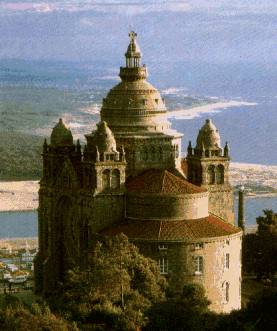|
|
|
|
| The history of Viana started
on Monte de Santa Luzia on which there is now a modern temple. For the
young and fit the climb to the top of the dome (Zimborium) will be memorable.
. 
Behind the temple there is a Pousada standing next to the old hill top village with the remains of many Celtic stone huts. This old village was inhabited from about 2000 BC until 1500 AD. Its decline began with the Roman invasion of Portugal since the Roman legions had to be fed and to achieve this they made the hunter/gatherers living in these hilltop Celtic villages move down into the valleys to become farmers. Explorers and colonists set
sail from Viana but its wealth came from trade with Brazil and the town
and countryside has many fine houses built by these wealthy men. Many of
them have partially opened to the public, in return for state funds for
restoration, by operating a very high class bed and breakfast establishment.
The old town, a relative
term, has narrow streets and alleys and cathedral. within its area is also
the old hospital (now the tourist office). It still retains its Jewish
quarter whose original inhabitants were fleeing from persecution in Aragon,
Spain.
When the merchants became wealthy from the trade with Brazil and other colonies, they were able to build many fine houses in and around the town. Also favoured was further up the river valley where Ponte de Lima is now situated. Attached to the Misericordia is a 17th Century Church with fine tiles decorated with pictures from the Old Testament. The square also contains a fountain constructed in 1553 and the 16th Century old Town Hall. Many of the fine houses built by the merchants have been preserved but now have different uses. This makes it a very interesting town to walk around.
It is not admitted in Porto, but the first Port Wine originated from Viana. It was red wine fortified with brandy which the sailors took with them when fishing on the Grand Banks in Newfoundland. This was exchanged for nets from England where it arrived as Portugal wine, later shortened to Port Wine. When the port silted up about 150 years ago the trade moved to Vila Nova de Gaia on the opposite side of the Douro river to Porto. The wine of the region is called Vinho Verde (literal translation 'green wine') which comes in either red or white varieties. Green in this case probably refers to a young wine. The wine is naturally slightly sparkling and works especially well with the fish caught from this port. The surrounding countryside is of small fields within granite walls. The grapes are grown around the edge of these fields and in the centre are the cabbage on the corn. The corn is used to make maize bread and also to feed the animals which are kept underneath the houses.
Viana has traditionally been linked with trading by sea. There is a very busy, modern shipyard but there are still smaller boat builders building wooden fishing boats on the beach or, under cover. During the third week of August, Viana is home to one of the world's major 'festas' in honour of Nossa Senhora de Agonia. There are three days of processions, dancing, bullfights etc. finishing with a spectacular firework display. In the fishing quarter the streets are decorated with flowers over which the statue of the Madonna is carried. The town is full of people in national dress, the 'traje'. For males looking for a wife looks are not as important as the dowry she will bring in the form of the gold worn with the national costume. |